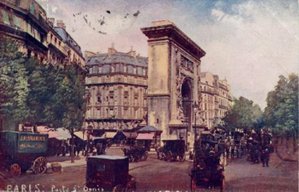
Porte Saint-Denis
Encyclopedia

Paris
Paris is the capital and largest city in France, situated on the river Seine, in northern France, at the heart of the Île-de-France region...
ian monument located in the 10th arrondissement, at the site of one of the gates of the Wall of Charles V
Wall of Charles V, Paris
The wall of Charles V, built from 1356 to 1383 is one of the city walls of Paris. It was built on the right bank of the river Seine, outside the wall of Philippe Auguste and replaced it. In the 1640s, the western part of the wall of Charles V was demolished and replaced by the larger Louis XIII...
, one of the now-destroyed fortifications of Paris
City walls of Paris
Over time, several city walls of Paris were built :* a gauloise enclosure * a Gallo-Roman wall* two medieval walls including the main one : the wall of Philippe Auguste* the wall of Charles V, extending on the right bank...
. It is located at the crossing of the Rue Saint-Denis
Rue Saint-Denis (Paris)
Rue Saint-Denis is one of the oldest streets in Paris. Its route was first laid out in the 1st century by the Romans, and then extended to the north in the Middle Ages. From the Middle Ages to the present day, the street has become notorious as a place of prostitution...
continued by the Rue du Faubourg Saint-Denis, with the Boulevard de Bonne-Nouvelle and the Boulevard Saint-Denis.
History
The Porte Saint-Denis was designed by architectArchitect
An architect is a person trained in the planning, design and oversight of the construction of buildings. To practice architecture means to offer or render services in connection with the design and construction of a building, or group of buildings and the space within the site surrounding the...
François Blondel
François Blondel
Nicolas-François Blondel was a soldier, engineer of fortifications, diplomat, civil engineer and military architect, called "the Great Blondel", to distinguish him in a dynasty of French architects. He is remembered for his Cours d'architecture which remained a central text for over a century...
and the sculptor Michel Anguier at the order of Louis XIV in honor of his victories on the Rhine and in Franche-Comté
Franche-Comté
Franche-Comté the former "Free County" of Burgundy, as distinct from the neighbouring Duchy, is an administrative region and a traditional province of eastern France...
. Built in 1672 and paid for by the city of Paris, it replaced a medieval gate in the city walls built by Charles V
Charles V of France
Charles V , called the Wise, was King of France from 1364 to his death in 1380 and a member of the House of Valois...
in the 14th century.
A monument defining the official art of its epoque, the Porte Saint-Denis provided the subject of the engraved frontispiece to Blondel's influential Cours d'architecture, 1698. It was restored in 1988.
Description
The Porte Saint-Denis is a triumphal archTriumphal arch
A triumphal arch is a monumental structure in the shape of an archway with one or more arched passageways, often designed to span a road. In its simplest form a triumphal arch consists of two massive piers connected by an arch, crowned with a flat entablature or attic on which a statue might be...
inspired by the Arch of Titus
Arch of Titus
The Arch of Titus is a 1st-century honorific arch located on the Via Sacra, Rome, just to the south-east of the Roman Forum. It was constructed in c.82 AD by the Roman Emperor Domitian shortly after the death of his older brother Titus to commemorate Titus' victories, including the Siege of...
in Rome
Rome
Rome is the capital of Italy and the country's largest and most populated city and comune, with over 2.7 million residents in . The city is located in the central-western portion of the Italian Peninsula, on the Tiber River within the Lazio region of Italy.Rome's history spans two and a half...
. It is pierced by a large central arch and formerly by two much smaller flanking pedestrian openings in the pedestals, now closed off. The arch is flanked by obelisk
Obelisk
An obelisk is a tall, four-sided, narrow tapering monument which ends in a pyramid-like shape at the top, and is said to resemble a petrified ray of the sun-disk. A pair of obelisks usually stood in front of a pylon...
s applied to the wall face bearing sculptural groups of trophies of arms
Trophy
A trophy is a reward for a specific achievement, and serves as recognition or evidence of merit. Trophies are most often awarded for sporting events, from youth sports to professional level athletics...
. Above the main arch, the southern face carries a sculptural group by Michel Anguier of "The Passage of the Rhine" in a sunk panel, while the north face carries allegorical figures of the Rhine and Holland. The entablature bears the gilded bronze inscription LUDOVICO MAGNO, "To Louis the Great".

